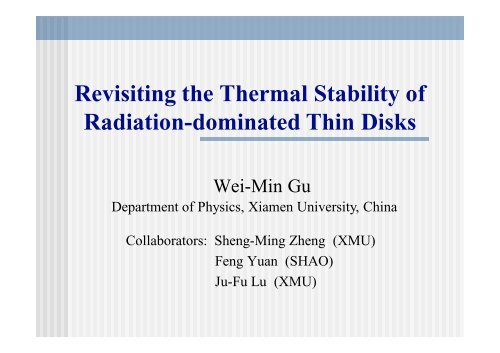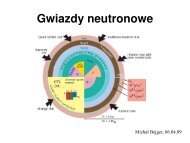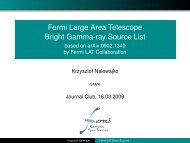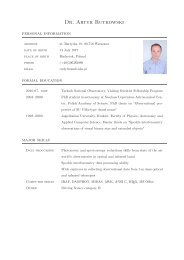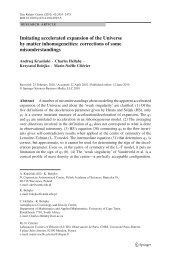Revisiting the Thermal Stability of Radiation ... - Users' Pages
Revisiting the Thermal Stability of Radiation ... - Users' Pages
Revisiting the Thermal Stability of Radiation ... - Users' Pages
- No tags were found...
Create successful ePaper yourself
Turn your PDF publications into a flip-book with our unique Google optimized e-Paper software.
<strong>Revisiting</strong> <strong>the</strong> <strong>Thermal</strong> <strong>Stability</strong> <strong>of</strong><strong>Radiation</strong>-dominated Thin DisksWei-Min GuDepartment <strong>of</strong> Physics, Xiamen University, ChinaCollaborators: Sheng-Ming Zheng (XMU)Feng Yuan (SHAO)Ju-Fu Lu (XMU)
Outline• Background and Motivation• Standard accretion disk <strong>the</strong>ory confronts <strong>the</strong> reality• Accretion disk model with toroidal magnetic fields• <strong>Thermal</strong> instability analysis <strong>of</strong> <strong>the</strong> newaccretion disk model• Equations• <strong>Stability</strong> properties• Summary & Discussion1
I.1 Instability <strong>of</strong> <strong>the</strong> SSD• Shakura-Sunyaev Disk(SSD)• Secular Instability•∂ M< 0∂Σ• <strong>Thermal</strong> Instability+ −∂ ( Q − Q )> 0∂TΣ• The Critical Pointβ = P gasP tot= 0.4LLEdd=. .log M/M Edd•M•M EddR = 5 Rgα M~ 0.05( ⋅0.1 10MBHsun)1−8β = 2 5(5RRg)21162
I.1 “Black hole accretion discs: reality confronts <strong>the</strong>ory”High Luminosity X-ray BinariesL = 0.01~0.5 L EddGierliński & Done,MNRAS, 20043
I.2 Accretion Disks with Toroidal Magnetic Fields• Inclusion <strong>of</strong> <strong>the</strong> effect <strong>of</strong> magnetic fields(e.g., Oda et al., ApJ, 2009)• The ViscosityThe α viscosity law is qualitatively right (Hirose etal. 2009, Pessah et al. 2007), when considering <strong>the</strong> MRIdriven turbulence.Trϕ= −2αH( Pgas+ Prad+ Pmag)• The vertical hydrostatic equilibrium12Ω 2KΣH = P + P +gasradPmagP mag=2Bϕ / 8π4
I.2 Magnetically Supported Accretion DiskStable?Or not?Abramowiczet al. (1995)Standard model withno magnetic fieldOdaet al. (2009)toroidal magnetic fields incorporated5
II.1 Equations <strong>of</strong> Local Disk SolutionsPtot=12Ω2KΣH····vertical hydrostatic equilibriumPtotTQrϕ=+visPgas+Prad+Pmag=kmΣTH1•∧= −2αPtotH= − ΩKM (1 − 3/ R)2π− −= Qrad+ QadvBH+13aT24< Bϕ>•2 23Q+ − 16cPradvis= − ΩKTrϕ, Q =2κΣ, − ξ M ΩKH( radQadv=2 )2πR+8π····equation <strong>of</strong> state····viscosity prescription & angular momentum conservation····energy equation6
Constraint on <strong>the</strong> relation between B φ and HBHa perturbation in <strong>the</strong> vertical directionPresumption: duringa<strong>the</strong>rmalperturbationR• δ Bϕ δ H , γ isafree parameter which is positive.Bϕ= −γH•γThe integrated form<strong>of</strong> this relation Φγ≡ BϕH = const holds . true withina<strong>the</strong>rmal timescale.• Alargerγ denotesstronger reaction<strong>of</strong> B φ on<strong>the</strong> perturbation<strong>of</strong>H(orT).BH<strong>the</strong> scale height increases and <strong>the</strong> meantoroidal magnetic field becomes weakerPartially supported by <strong>the</strong> simulations <strong>of</strong>magnetic thick disks (Machida et al. 2006)RHB φ7
II.2 Perturbation Analysis• Relations between <strong>the</strong> first order perturbationδ<strong>of</strong> each physical quantityP1H1Σ= , 1Trϕ,1 P= 0,1H P1 mag,1H= + , = −2γP0H0 Σ0 Trϕ,0P0H0Pmag,0H(t vis >> t th )PP1T1Σ1H1T1mag ,1= βgas⋅(+ − ) + 4(1 − βgas− βmag) ⋅ + βmag⋅P0T0Σ0H0T0Pmag, 010BBϕϕδ= −γβ gas= P gas/Pβ mag= P mag/PHHQQ+vis,1−vis,0T=Trϕ,1rϕ,0P1=P0H+H10,QQ−rad ,1−rad ,0T= 4T10Σ−ΣWe express <strong>the</strong> perturbation <strong>of</strong> eachphysical quantity in terms <strong>of</strong> T 1 /T 0 , i.e.10,QQ−adv,1−adv,0T=Trϕ,1rϕ,00H+ 2 HX1 =X10TF(T10)8
II.2 <strong>Thermal</strong> Instability Criterion• ⎡⎢⎣∂+( Q − Q∂T−) ⎤⎥⎦Σ>0⎡Q⎢⎣Q+vis,1+vis,0−fadvQ⋅Q−adv,1−adv,0− (1 −fadvQ) ⋅Q−rad ,1−rad ,0⎤⎥⎦TT10>0f /− +adv= QadvQvis<strong>Thermal</strong> instability criterion:∆ =2 − 5β − 4(1 + γ ) β − 6 f + 8 f β + (8 + 4γ)gasmagWhen Δ>0, disk solutions are <strong>the</strong>rmally unstable.advadvgasfadvβmag9
II.3 <strong>Thermal</strong> Instability PropertiesΔ < 0Δ > 0Critical mass accretion rates <strong>of</strong> <strong>the</strong> magnetized thin disk with different γ.The curves correspond to <strong>the</strong> states where Δ=0. The disk is <strong>the</strong>rmallystable when <strong>the</strong> ratio <strong>of</strong> magnetic to total pressure is over 0.25.10
II.3 S-curves <strong>of</strong> Local Disk Solutions~ L Eddstandard solutionswithout magnetic fieldS-curves with different values <strong>of</strong>Φ 1= B ϕHOur model may help raise <strong>the</strong> critical accretion rate (or luminosity)for <strong>the</strong> <strong>the</strong>rmal instability, which may be consistent with <strong>the</strong>observed X-ray sources with high luminosities.11
III. Summary• By assuming that <strong>the</strong> field responds negatively to a positivetemperature perturbation, we find that <strong>the</strong> critical massaccretion rate increases significantly. This accounts for <strong>the</strong>stability <strong>of</strong> <strong>the</strong> observed sources with high luminosities.• Our model also presents a possible explanation as to why onlyGRS 1915+105 seems to show <strong>the</strong>rmally unstable behavior.This peculiar source holds <strong>the</strong> highest accretion rate (orluminosity) among <strong>the</strong> known high state sources.12
III. Discussion• Compared with simulation: two problems• Requiring stronger magnetic fields (0.1 < β mag < 0.25)Simulations: β mag < 0.1 (e.g., Hirose et al. 2009)• Magnetic field reversal: beyond explanation by our modelOur paper: ApJ, 732, 52 (05/2011)13


